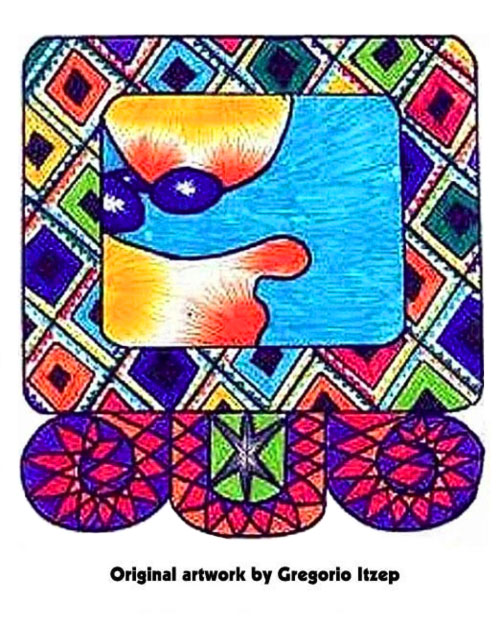
Cimi Trecena
by Kenneth Johnson
In the Popol Vuh or Mayan Creation Epic, the Lords of Death demanded the presence of the Hero Twins in the world below. The two most powerful chieftains of this Underworld realm—two animated skeletons with a penchant for cigars—were named 1 Death and 7 Death. The Hero Twins were subjected to numerous trials and initiatory experiences. They played handball with the Lords of Death, who tricked them into losing the game and forfeiting their lives. The twins sacrificed themselves by leaping into a fiery oven, but on the fifth day they rose again, emerging from the river of the Underworld as a pair of catfish.
This drama, in which the Lords of the Underworld play a treacherous but initiatory role, suggests that the day or nagual called Death is symbolic of transformation rather than physical death.
Throughout ancient Mexico, a system of magical correspondences governed the meaning of each day sign. One of the correspondences attributed to Death was the cardinal direction North (although most contemporary daykeepers perceive it as south). In ancient times, North was the direction that symbolized the Ancestors, but was only the direction of “death” in the sense that the Ancestors have departed the physical plane. Nevertheless, they continue to guide us with their wisdom, and seeking that wisdom was part of the essence of Mayan ritual practice. In the day sign Death, we become one with those who went before us, and we partake of their wisdom. In an old Aztec codex which correlates the day signs with organs of the human body, Death is associated with the crown chakra, the sacred center through which solar enlightenment and ancestral wisdom may best enter into our own consciousness. Hence this day sign bestows upon us the ancestral wisdom that guides us through all our transformations.
Another key to the transformative process embodied in this day-sign is the Moon God, who, according to the Aztec system of correspondences, ruled this sign. He is represented as an old man who carries a conch shell on his back. This conch is the moon as it rises over the ocean, illuminating the dark waters of the soul with its brilliant white light. Of course, the moon goes through a cycle of death and rebirth each month as it passes through its various phases. The Moon God is an elder, a wise old man, and the conch, because of its spiral shape, is a symbol of the eternal cycle of birth and death—yet another symbol of transformation. This wise old god sometimes wears butterfly wings, reminding us that the butterfly was a caterpillar until it wrapped itself in its transformative cocoon. It also reminds us that butterflies are said by the Maya to be the souls of the dead.
Because this day-sign is often referred to simply as “Death,” and because it is symbolically connection with owls, cemeteries, and so on, many Westerners cringe at the thought of being born upon such a day. And yet the Maya themselves tend to see this nagual as a positive force. The word for the grammatical “present tense” in some Mayan languages is kame or kamic as well. Death is the Eternal Now, the present moment, and death – whether physical or spiritually transformative — cannot happen at any other time. Death transforms the Present into the Past, giving birth to the Future. The Eternal Now is like an axis mundi or world center. Both the Past, comprised of that which has been and gone, and the Future, yet to come, are anchored to the central tree of the Eternal Now. Living, as we do, in the Eternal Now, our eloquent poetic words and our beautiful lives feed the Past and thus create the blossoming of the Future. If the Gods become drunk with our beauty, we heal the Past and make it new. Thus is the Future created. We are not fully “cooked” in the glorious oven of human life until we die; death completes us.
This is the esoteric meaning of the day-sign called Death. This is why Death, much against our own Western expectations, is one of the most positive day-signs of all. Since this is a very positive sign, it has a deeper mythic relationship with the paradise side of the Underworld rather than fearsome Xib’alb’a. This is a day of communication with the ancestors and with unseen worlds.
In fact, it sometimes seems as if the Gods of the Otherworld have endowed these citizens of the “eternal now” with a kind of eternal youth. Cimi people can be truly ageless and give the appearance of being “forever young.”
http://www.jaguarwisdom.org

